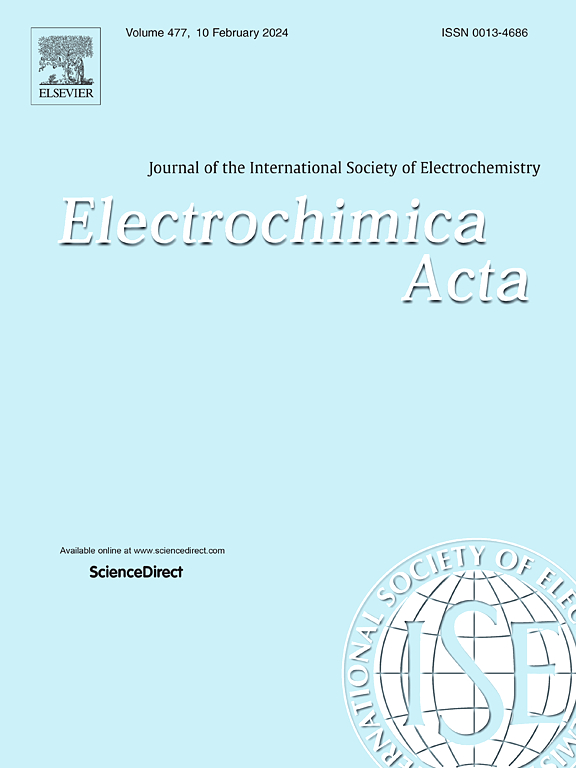Direct regeneration of cathode materials from spent lithium-ion batteries using ternary lithium molten salt
IF 5.6
3区 材料科学
Q1 ELECTROCHEMISTRY
引用次数: 0
Abstract
The recycling of spent lithium-ion batteries (LIBs) is critical for alleviating resource scarcity and mitigating environmental pollution. While the current industrial approaches primarily rely on pyrometallurgy and hydrometallurgy, these methods exhibit inherent limitations. In recent years, new ideas for direct repair and regeneration of spent LiNixCoyMnzO2 (SNCM) cathode materials have emerged. Through innovative processes, the lithium ion (Li+) is added to SNCM cathode materials, so that the performance of SNCM cathode materials were restored and the “secondary life” of SNCM cathode materials were realized. In this work, we propose a new method for SNCM cathode materials based on a ternary lithium molten salt (TLMS) system. Combined with FactSage software, the phase diagrams of Li2CO3-LiNO3, Li2SO4-LiNO3 and Li2SO4-Li2CO3 systems were constructed to reveal the synergistic effect of lithium salts at high temperature, and the optimal repair temperature and ternary molten salt ratio were determined. The characterization showed that MR-NCM-60 % showed a single lattice fringe after repair, the I (003)/I(104) ratio reached the peak and the Mn3+ content decreased significantly, confirming the reverse transformation of the rock salt/spinel phase to the layered structure. Electrochemical tests show that MR-NCM-60 % retained a discharge capacity of 93.78 mAh g-1 after 200 cycles at 0.2 C, and the rate performance is the best, which is attributed to the inhibition of Li/Ni cation mixing and the improvement of structural stability. This study provides a new idea for the repair and regeneration of SNCM cathode materials.
利用三元锂熔盐直接再生废锂离子电池正极材料
废旧锂离子电池的回收利用对于缓解资源短缺和环境污染具有重要意义。虽然目前的工业方法主要依靠火法冶金和湿法冶金,但这些方法具有固有的局限性。近年来,对废LiNixCoyMnzO2 (SNCM)正极材料的直接修复和再生出现了新的思路。通过创新工艺,将锂离子(Li+)添加到SNCM正极材料中,恢复了SNCM正极材料的性能,实现了SNCM正极材料的“二次寿命”。本文提出了一种基于三元锂熔盐(TLMS)体系制备SNCM正极材料的新方法。结合FactSage软件,构建Li2CO3-LiNO3、Li2SO4-LiNO3和Li2SO4-Li2CO3体系的相图,揭示高温下锂盐的协同作用,确定最佳修复温度和三元熔盐比。表征结果表明,修复后的MR-NCM-60%呈现单一晶格条纹,I(003)/I(104)比值达到峰值,Mn3+含量显著下降,证实了岩盐/尖晶石相向层状结构的反向转变。电化学测试表明,在0.2℃下循环200次后,MR-NCM-60%的放电容量为93.78 mAh g-1,且倍率性能最好,这是由于抑制了Li/Ni阳离子的混合,提高了结构稳定性。本研究为SNCM阴极材料的修复和再生提供了新的思路。
本文章由计算机程序翻译,如有差异,请以英文原文为准。
求助全文
约1分钟内获得全文
求助全文
来源期刊

Electrochimica Acta
工程技术-电化学
CiteScore
11.30
自引率
6.10%
发文量
1634
审稿时长
41 days
期刊介绍:
Electrochimica Acta is an international journal. It is intended for the publication of both original work and reviews in the field of electrochemistry. Electrochemistry should be interpreted to mean any of the research fields covered by the Divisions of the International Society of Electrochemistry listed below, as well as emerging scientific domains covered by ISE New Topics Committee.
 求助内容:
求助内容: 应助结果提醒方式:
应助结果提醒方式:


